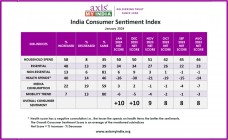Biodegradable materials drive freshness label market to grow, says report
By Retail4Growth Bureau | January 12, 2024
Future Market Insights, Inc.'s latest report paints a promising picture for the freshness indicator label market, fueled by rising consumer demand for transparency and convenience.

A Future Market Insights report says the Freshness Indicator Label Market is estimated to surpass US$ 170.2 million in 2024. The industry is projected to reach US$ 307.5 million by 2034. It says the demand for freshness indicator label is likely to register a CAGR of 6.1% from 2024 to 2034. One significant factor behind this demand is the increasing global awareness and emphasis on reducing food waste. “Consumers are more conscious of sustainable practices, pushing manufacturers to adopt freshness indicator label that help minimize waste by providing accurate information on product shelf life. Additionally, stringent government regulations regarding food safety and labeling contribute to the industry's growth as companies strive to meet and exceed these standards, fostering consumer trust,” says the report.
One notable challenge is the cost of implementing advanced technologies like smart sensors and IoT integration in freshness indicators. The initial investment and ongoing maintenance expenses can be barriers for some companies, especially smaller ones. Furthermore, the need for standardization across the industry poses a restraint, as varying standards and regulations can complicate operations and limit the seamless exchange of freshness information between different products and regions, the report adds.
The increasing demand for customized freshness indicator labels tailored to specific products presents a notable opportunity for companies to differentiate themselves in the market. A noteworthy trend is the integration of freshness indicators with augmented reality (AR) technology, creating interactive and engaging consumer experiences. This not only enhances the overall consumer experience but also strengthens brand engagement. Another emerging trend involves the use of color-changing technology in freshness indicator label, offering an intuitive visual cue for consumers to quickly assess the freshness of products. This trend aligns with the increasing demand for convenient and easily interpretable freshness information.
"A freshness indicator label is an innovative packaging solution that provides consumers with real-time information about the freshness of a product," says Ismail Sutaria (Lead Consultant, Packaging and Materials). "These labels, often incorporating time-temperature indicators, enhance transparency and help consumers make informed decisions about the quality and safety of perishable goods."
Key Takeaways from the Freshness Indicator Label Market
- Moisture content indicators are expected to dominate with a 24.7% share in the freshness indicator label industry in 2024.
- The food end use industry leads the freshness indicator label industry, accounting for a 32.7% share in 2024.
- The China freshness indicator label industry is expected to expand at a 7.1% CAGR through 2034.
- The freshness indicator label market in India is expected to develop at a 7.9% CAGR through 2034.
- The freshness indicator label industry in Germany is predicted to increase at a 4.0% CAGR until 2034.
- The freshness indicator label industry in the United States is expected to witness a modest 4.2% CAGR through 2034.
- The United Kingdom freshness indicator label market is predicted to expand at a 5.4% CAGR through 2034.
The freshness indicator label industry promises immense potential for companies that are adept at adaptation, innovation, and addressing key concerns, positioning themselves to thrive in this dynamic and burgeoning market. Importantly, collaborative efforts between industry players, ranging from established giants to agile startups, have the potential to foster innovation and expedite the development of even more advanced and accessible freshness indicator label solutions, thereby benefiting consumers and the broader food industry.









Comments